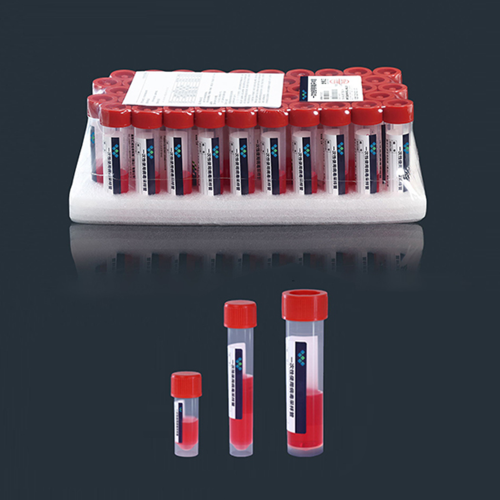Jul 01,2022
Viral Transport Media (VTM) is a specialized solution used to transport and store clinical specimens, particularly those suspected of containing viral pathogens. It is designed to maintain the viability and integrity of the viruses present in the specimens during transit from the collection site to the laboratory for further analysis and testing. VTM provides a controlled environment that helps preserve the viability of viruses and prevents their degradation or inactivation.
VTM typically consists of a buffered saline solution supplemented with various components to support the survival of viruses. These components may include proteins, antibiotics, antifungal agents, and pH stabilizers. The specific formulation of VTM can vary depending on the intended use, the type of viruses being targeted, and the preferences of the laboratory or healthcare institution.
The primary purpose of VTM is to ensure the stability and viability of the viral specimens until they can be processed in the laboratory. It helps prevent the growth of bacteria and fungi that could potentially interfere with viral testing or lead to specimen degradation. VTM also helps maintain the integrity of viral genetic material, which is crucial for accurate diagnosis and molecular testing methods such as polymerase chain reaction (PCR) or viral culture.
When collecting a specimen suspected of viral infection, such as respiratory secretions or swabs from the nasopharynx or oropharynx, the sample is placed in a vial or tube containing VTM. The specimen is then mixed or swirled in the VTM to ensure proper preservation and distribution of the viruses throughout the solution. The sealed vials are labeled, packaged, and transported to the laboratory for analysis while maintaining the required cold chain conditions, if applicable.
In the laboratory, the VTM-containing specimens are subjected to various diagnostic techniques, such as viral culture, PCR, or antigen testing, to detect and identify the presence of specific viral pathogens. The use of VTM helps ensure the accuracy and reliability of these tests by providing an optimal environment for virus survival and detection.
Overall, Viral Transport Media plays a crucial role in the transportation and preservation of viral specimens, enabling accurate diagnosis, surveillance, and research related to viral infections. It helps maintain the viability of viruses, prevents their inactivation or degradation, and supports effective testing and analysis in the laboratory.Meanwhile,Viral Transport Media (VTM) can be classified based on various factors, including composition, purpose, and specific viral pathogens targeted. Here are some common classifications of VTM:
Composition-based classification:
a. Liquid-based VTM: This type of VTM consists of a liquid solution, typically a buffered saline solution, supplemented with various components like proteins, antibiotics, antifungal agents, and pH stabilizers. These additives help maintain the viability and integrity of viruses during transportation and storage.
b. Gel-based VTM: Gel-based VTM contains a semi-solid gel matrix, such as agarose or carboxymethylcellulose, suspended in a liquid medium. The gel matrix helps to preserve the integrity of the viral specimen while allowing for the controlled release of viruses during testing.
Purpose-based classification:
a. Diagnostic VTM: This type of VTM is specifically formulated for the purpose of diagnostic testing. It provides an optimal environment for preserving viral viability and integrity during transportation to the laboratory, ensuring accurate and reliable results.
b. Research VTM: Research-grade VTM is designed for preserving viral specimens for research purposes, such as studying viral pathogenesis, conducting epidemiological studies, or developing new diagnostic methods. It may have specific formulations tailored to the needs of research projects.
Viral pathogen-based classification:
VTM can also be classified based on the targeted viral pathogens:
a. Respiratory VTM: These are designed to transport and preserve respiratory specimens, including nasopharyngeal or oropharyngeal swabs, sputum, or bronchoalveolar lavage (BAL) samples. They are commonly used for respiratory viral pathogens such as influenza viruses, coronaviruses, respiratory syncytial virus (RSV), etc.
b. Enteric VTM: Enteric VTM is formulated to transport and preserve fecal specimens for the detection of enteric viruses like rotavirus, norovirus, adenovirus, and others.
c. Genital VTM: Genital VTM is used for collecting and preserving specimens from the genital tract, such as vaginal swabs or cervical samples, for the detection of sexually transmitted viruses like human papillomavirus (HPV), herpes simplex virus (HSV), or human immunodeficiency virus (HIV).
These classifications may vary based on regional or institutional practices, as different laboratories or healthcare systems may have their own specific formulations or categorizations of VTM based on their testing needs. It's important to follow the guidelines and recommendations provided by the relevant regulatory bodies or testing authorities when selecting and using VTM for specific viral diagnostic purposes.





 Español
Español
 Français
Français
 Deutsch
Deutsch
 عربى
عربى








